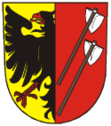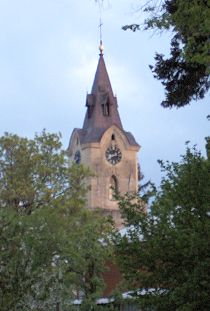Horní Benešov
| Horní Benešov | ||||
|---|---|---|---|---|
|
||||
| Basic data | ||||
| State : |
|
|||
| Region : | Moravskoslezský kraj | |||
| District : | Bruntál | |||
| Area : | 2040 ha | |||
| Geographic location : | 49 ° 58 ' N , 17 ° 36' E | |||
| Height: | 568 m nm | |||
| Residents : | 2,253 (Jan 1, 2019) | |||
| Postal code : | 793 12 | |||
| structure | ||||
| Status: | city | |||
| Districts: | 2 | |||
| administration | ||||
| Mayor : | Josef Klech (as of 2006) | |||
| Address: | Masarykova 32 793 12 Horní Benešov |
|||
| Municipality number: | 597350 | |||
| Website : | www.hbenesov.cz | |||
Horní Benešov , until 1926 Benešov , (German Benisch or Bennisch ) is a town in the Czech administrative district Bruntál ( Freudenthal ).
Geographical location
The city is located on the right side of the Cziczina in the Moravian-Silesian Region , about 15 kilometers southwest of Jägerndorf ( Krnov ), near the Polish border.
history

Benisch was first mentioned on April 11, 1253, when the "subcamerarius regis Bohemie" Beneš / Benesch commissioned the two locators Erwig and Guido with the creation of a city under Leobschützer law , which should bear his name. A hereditary bailiwick was assigned to the locators . Silver mining was of paramount economic importance until the 16th century. Gold, copper and iron ores were also mined.
Together with the Duchy of Jägerndorf , Beneschau came to Georg von Ansbach in 1523 , which caused Protestantism to spread. Georg Friedrich raised Benisch to free mining town in 1567 , for which he issued mining regulations in 1590 . Mining came to a standstill in the Thirty Years' War. Because of the religious policy of the Habsburgs , who had been kings of Bohemia since 1526, most of the population returned to the Catholic faith after 1630. Fires ravaged the city several times.
An economic boom followed in the 19th century with the textile industry ( Bennischer Leinen ) and the mining of slate and iron ore . In 1898 a community school was built. Bennisch was the seat of a district court.
After the Munich Agreement , Bennisch was assigned to the German Reich . The city belonged until 1945 to the district Freudenthal in the administrative district of Opava in the Reich District of Sudetenland .
The town of Bennisch had 3,409 inhabitants on December 1, 1930 and 3,414 on May 17, 1939. Until the end of the Second World War in 1945, almost exclusively German speakers lived in Bennisch. After the war ended, the city returned to Czechoslovakia. The German residents were expelled .
In 1970 the railway to Opava had to be shut down due to subsidence as a result of mining, today the nearest train station is in Svobodné Heřmanice . In 1992 the mine was shut down and textile production was greatly reduced.
Demographics
| year | Residents | Remarks |
|---|---|---|
| 1834 | 2,731 | (2,028 in the city and 703 in the suburbs) residents are Catholic Germans |
| 1900 | 4,367 | German residents |
| 1933 | 3,409 | |
| 1939 | 3,405 |
On May 22, 1947 the population was 1,530.
City arms
Half of the Silesian eagle is on the left and two rods on the right in the split city arms.
traffic
The main road from Troppau ( Opava ) to Freudenthal ( Bruntál ) runs through the urban area .
mayor
- 1885 to 1891 Wilhelm Machold
- 1891 to 1897 Friedrich Philipp, weaving manufacturer
- 1897 to 1900 Josef Reichel, major farmer
- 1900 to 1904 Karl Massl
- 1904 to 1912 Friedrich Philipp, weaving manufacturer
- 1912 to 1919 Adolf Schmeidel, weaving manufacturer
- 1919 to 1923 Hogo Schindler, master dyer
- 1923 to 1931 Adolf Rieger, master builder
- 1931 to 1936 Heinrich Bernt, Consumer Director
- 1936 to 1938 Richard Gerlich, orthopedic master shoemaker
- 1938 to 1945 Eduard Preuss, accountant
- May / June 1945 Anton Wiener
Attractions
- The Gothic Katharinenkirche dates from 1253. It was rebuilt after the town fire of 1820.
sons and daughters of the town
- Anton Karl Gebauer (1872–1942), Austrian Asian researcher and travel writer
- Fritz Kohn (1873–1921), Jewish brewery tenant, grandfather of John Kerry
- Walter Gotschke (1912–2000), German graphic artist, press draftsman and automobile illustrator
- Harald Wagner (1944–2016), German theologian
Twin cities
- Pszów , Poland
literature
- Faustin Ens : The Oppaland, or the Troppauer Kreis, according to its historical, natural history, civil and local characteristics . Volume 4: Description of the location of the principalities of Jägerndorf and Neisse, Austrian Antheils and the Moravian enclaves in the Troppauer district , Vienna 1837, pp. 56–58.
- Joachim Bahlcke , Winfried Eberhard, Miloslav Polívka (eds.): Handbook of historical places . Volume: Bohemia and Moravia (= Kröner's pocket edition . Volume 329). Kröner, Stuttgart 1998, ISBN 3-520-32901-8 , p. 29f.
Web links
- City of Benisch (Rolf Jehke, 2008)
- History (czech)
Individual evidence
- ↑ Český statistický úřad - The population of the Czech municipalities as of January 1, 2019 (PDF; 7.4 MiB)
- ↑ a b c Meyer's Large Conversation Lexicon . 6th edition, Volume 2, Leipzig and Vienna 1905, p. 638
- ↑ Faustin Ens : The Oppaland or the Opava district, according to its historical, natural history, civic and local peculiarities . Volume 4: Description of the location of the principalities of Jägerndorf and Neisse, Austrian Antheils and the Moravian enclaves in the Troppauer district , Vienna 1837, pp. 56–58.
- ↑ a b Michael Rademacher: German administrative history from the unification of the empire in 1871 to the reunification in 1990. Freudenthal district (Czech Bruntál). (Online material for the dissertation, Osnabrück 2006).



